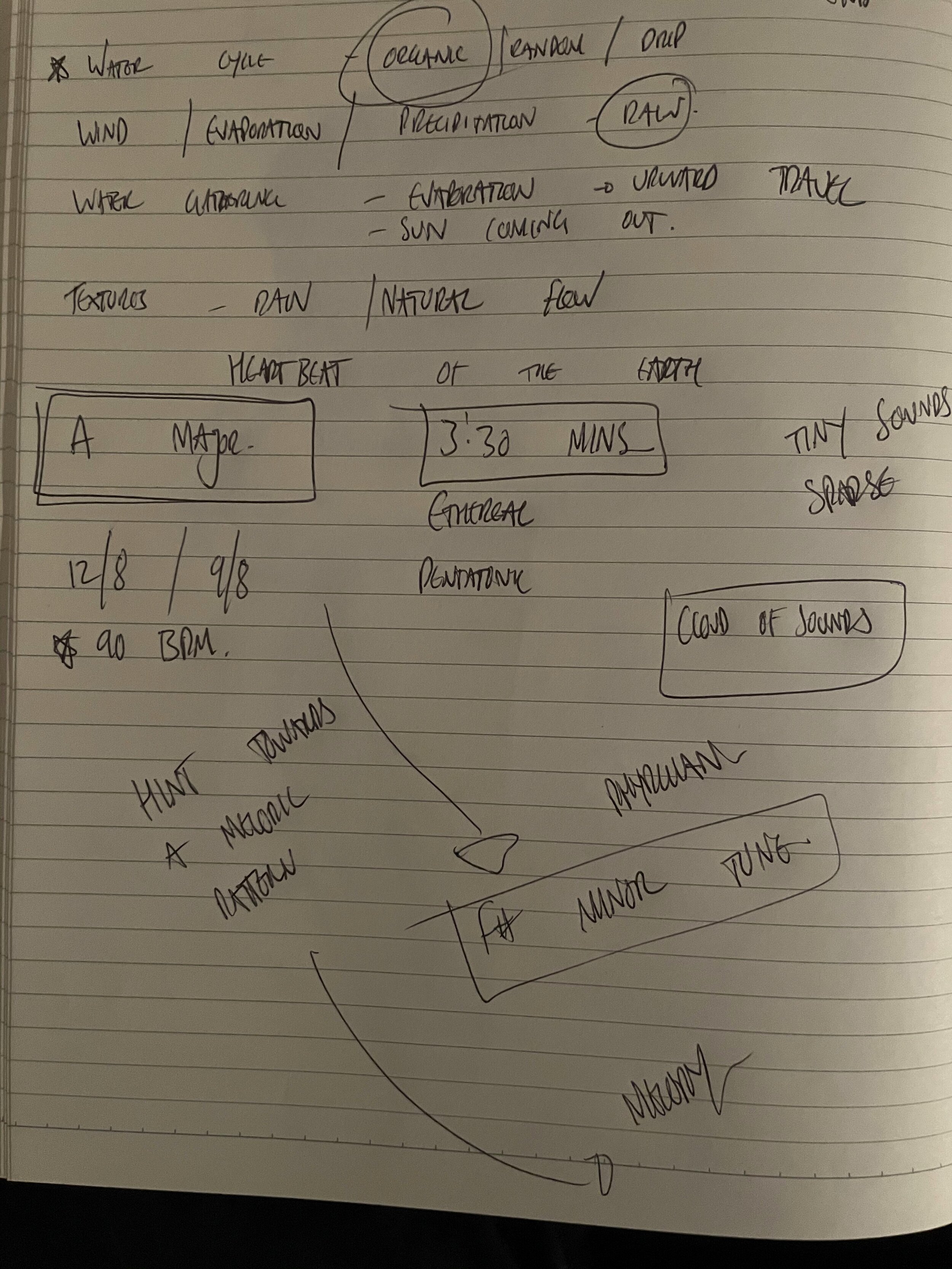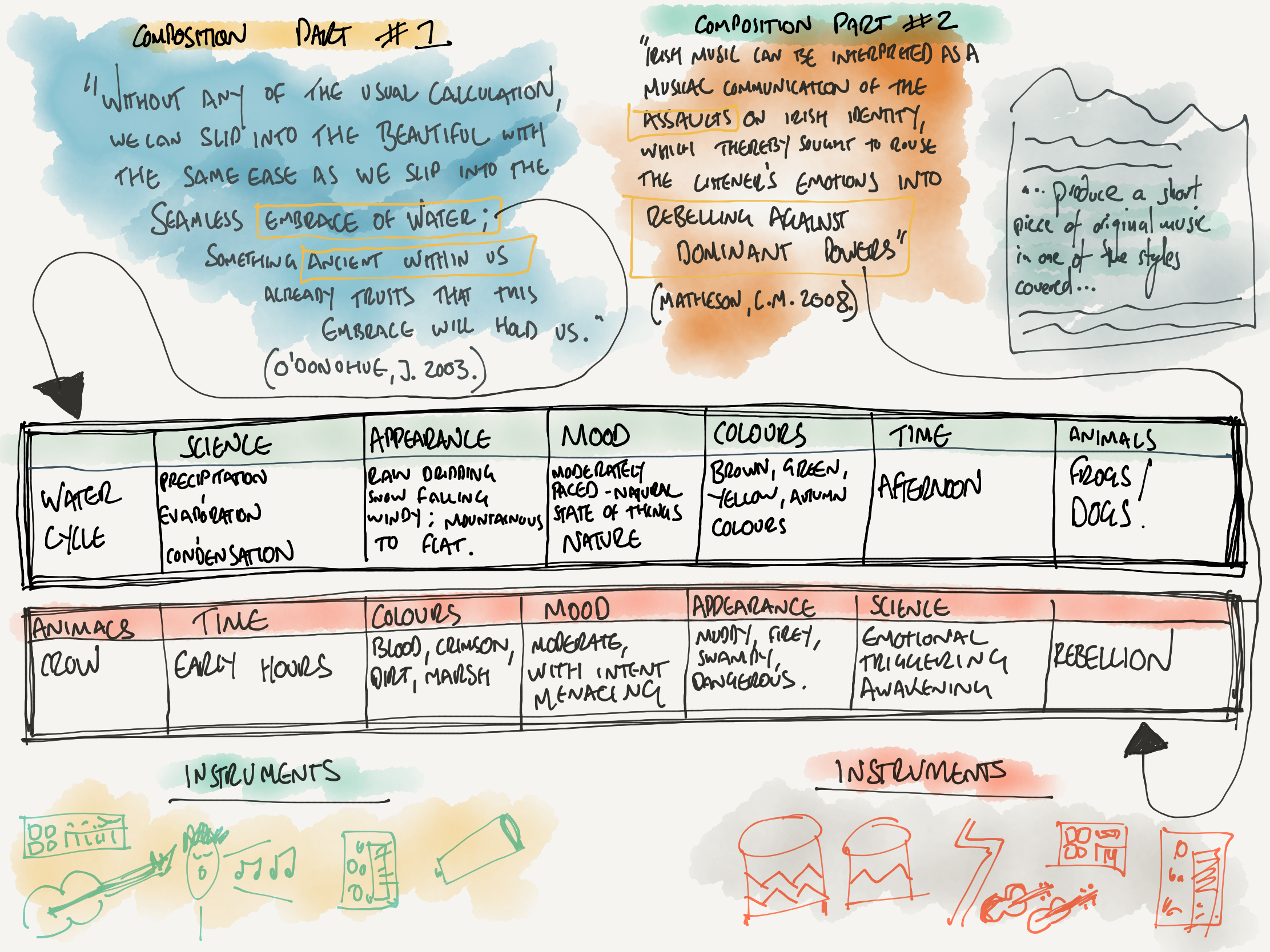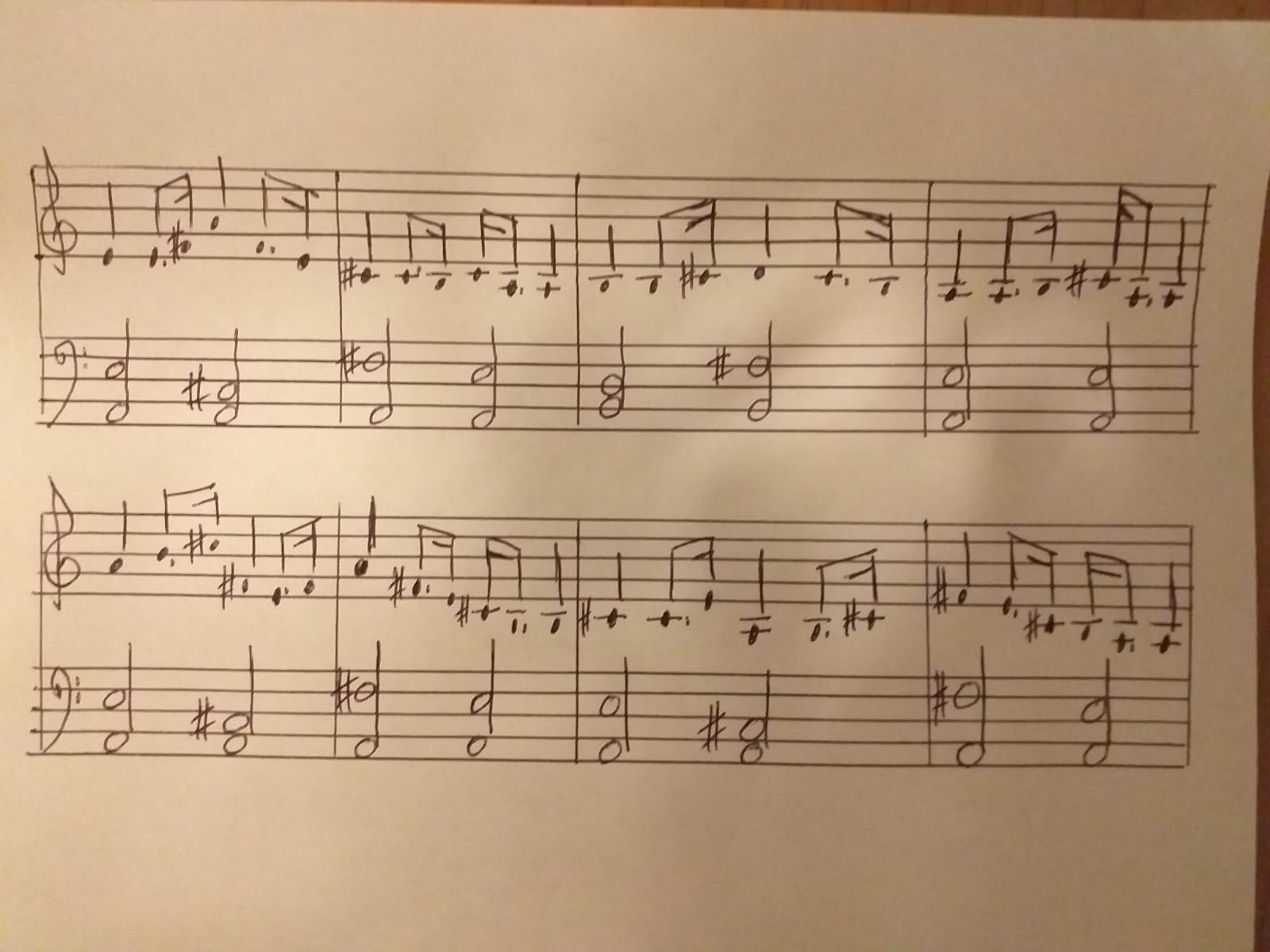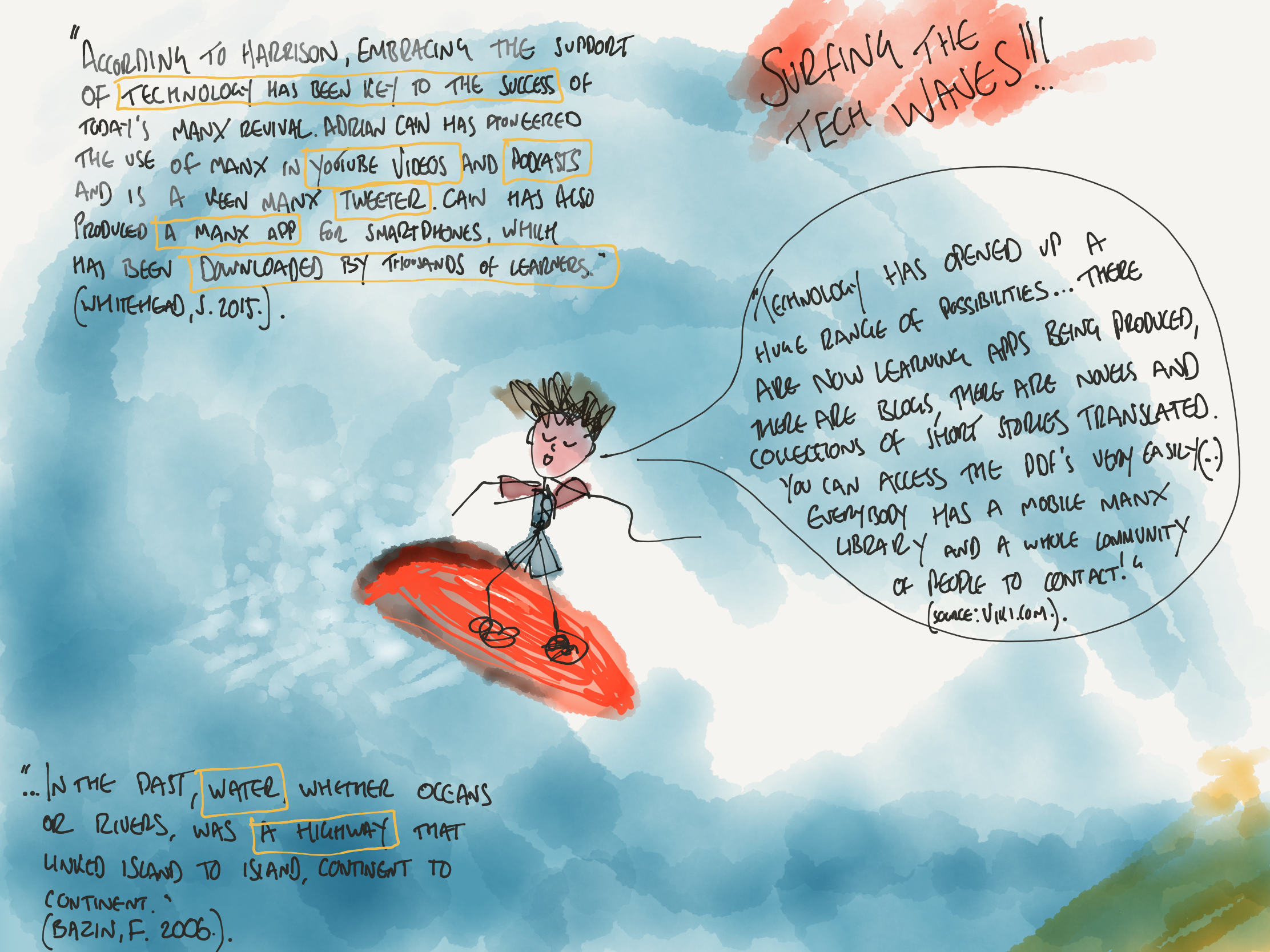1) The Hawthorn Tree
Defining the Celtic sound and its emotional connections to the lore of the Hawthorn Tree.
Green grow the leaves on the Hawthorn tree.
We jangle and we wrangle
And we never can agree
(Old English Carol)
I begin my enquiry with a drawing of the Hawthorn Tree:
The Hawthorn Tree is a battleground/playground for:
Tension vs. Release
Awakening vs. Surrendering
Joy vs. Despair
Intimate vs. Cinematic
Real World vs. Other World
You vs. Me
Britain vs. Ireland
The Old English Carol that I have chosen to quote above brings about the safe but charged elements I am so fascinated by in all of my enquiries at present - essentially, this tree is a site where creative chaos can flourish. A site where stories flow, music erupts, fairies dance and tension is concealed.
I have been a member of family gatherings in living rooms where stories flowed, music dominated and joy has danced - though, tension was visible and tangible, as in all families. Here is a collection of images of my early jangling and wrangling - offering a sense of my Celtic roots from my Grandmother’s Dumfriesshire village home, where I acquired all of my tunes from friends and family:
Hunkering into the acoustic guitar!
Living Room Jangle & Wrangle to the finest tunes from the timeless and seminal “First Ceilidh Collection” songbook!
My Grandmother’s living room was the place of my own mysterious encounters with the Celtic sound which I have been able to start self-defining and recognising in my practice as a songwriter. JRR Tolkien named its mystical and magical qualities very aptly:
Around 13 years ago, I was re-visiting Penpont with my friend Thomas Goldsworthy (whose dad Andy was and still is a famous land artist!) who was telling me about a new piece that his Dad was doing that involved shaking Hawthorn Trees. He then told me about the old myths he had heard that surrounded this important Celtic symbol. Here’s the result from his Dad’s experiment as well as some Hawthorn Tree facts:
Hawthorn Tree Facts
(Goldsworthy, A. Hawthorn Tree Shake 2008.).
I love the image of the human being absorbed by the tree branches - as if the human is attempting to cross a threshold from one realm to the other. This connotation is directly linked to the lore of the Hawthorn tree, whose imagery connotes a site or bridge where realities can meet. In this blog, I will be employing the metaphorical imagery connected to the lore of the Hawthorn Tree to help me explore and engage with the Celtic sound as well as the notion of ‘folk music’ which I spent a great deal of my childhood immersed in. I will explore the emotional connections using the imagery and the lore of the Hawthorn Tree to help frame my perspectives.
I will firstly offer my thoughts towards who the Celts were and their particular sound. As Phil Cunningham puts it within the BBC Documentary The World Accordion to Phil:
I’ve been asked a lot of times what I think being Celtic is.
I’m no very sure is the honest answer… for me I notice it
musically!
(Cunningham, P. 2002).
He suggests common traits within peoples’ make-up, including a sense of passion, a sense of romanticism, sense of adventure and sense of humour which binds people together. Goldsworthy’s Shaking the Hawthorn Tree also embodies these facets. I refer to the James Porter’s “Locating Celtic Music (and Song)” chapter to which presents some insight. He firstly refers to Arnold’s depiction of the make-up of the Celt: …the Celt, so eager for emotion. (Arnold 1910: 87-88) which is similar to Cunningham’s portrayal of the archetypal embodiment. Porter then refers to Harrison’s nod towards the plural notion of “Celtic Musics” which denotes a music containing multitudes, which is asserted by the inclusion of segments from René Abjean’s booklet La Musique Bretonne which suggest “Il n’y a pas une musique celtique il y a des musique celtiques.” (Abjean, R 1975). I like this multiplicity as it embraces the liberal hospitable notion of welcoming in different musical positions. To my mind, this is the solid ground that engenders Celtic Musics.
Those in power write the history, those that struggle write the songs
(Harte, F. 2010.).
The musics of the Celts has two main flavours, I would argue. One cinematic and vast (Celtic Sound), the other intimate and gentle (Folk Music). I understand the broad term folk music as a “less-is-more” acoustic performance, whose place is intimate – belonging to living rooms, dining rooms, pub snugs and community spaces. Instrumentally, vocals and acoustic guitar generally provide the main components and this is often supplemented by violin, mandolin, percussion, whistles, pipes and drones. The songs are telling of loss, longing, lust, love, lullaby and often are beautifully banal in their lyrical content – speaking of what is right in front of them, their everyday and their autobiographies. Home, identity, struggle and oppression often frame the meaning – the melody and harmony are often beautiful, fragile and emotive. My favourite folk singers who embody this definition include Pete Seeger, Karine Polwart, Inge Thomson, The Staves. A song that does this definition justice is Bill Callahan’s “Let’s Move to the Country.” This song is a great example of beauty in banality - something that is commonplace in folk music.
The notion of Celtic music, on the other hand, embodies grandeur and epicness. My initial impression on the form is that the production of the instruments is often reliant on bold reverb and rich EQing to give a cinematic, blockbuster impression perhaps inspired by the commonly perceived Celtic rugged environments. I often think that the notion of Celtic music is more instrumental in nature and relies on tradition within its performance - whether that be instrumentation, arrangements, overall timbre, etc. Bands that come to mind that symbolise this idea are the Scottish trio Talisk and Hò-Rò who rely on the fast, energetic melodic power of traditional pipes and violin to drive the music. The notion of Celtic music is often vocalised in Gaelic and gives way to a romanticised appearance of place over the reality. Appearance vs reality is a major theme that I feel is at the core of Celtic Musics and its discourse and this can be further exemplified through the lore of the Hawthorn Tree.
In the folklore specific to the Celtic Isles, the Hawthorn Tree is a gateway tree; that holds a doorway between the perceived ‘otherworld’ (appearance) and our physical realm (reality). This relates to my idea of the difference between folk music and Celtic sound, or, Appearance vs Reality. It is a tree that has been part of our society and rituals for hundreds, perhaps thousands of years. According to Celtic Tree Astrology, the tree symbolises the energies of people born between May 13th - June 9th. Therefore, this is also my tree sign, as my birthday falls upon June 3rd. It is a tree of hope, love, passion, commitment and challenges. The Celtic sound itself embraces these sonic signifiers plentifully, consoling the heaviness and desperation with serious joy and frolic. The complexity of the music makes me think back to the family gatherings in my Grandmother’s Dumfriesshire village home with visible and tangible tension dominated by musical joy. To help me engage further with this initial discourse, I feel now is the time to create a song response that encapsulates these notions.
References:
BBC, “The World Accordion to Phil” (2011). Available From: https://www.bbc.co.uk/programmes/b00zp6nh Accessed October 10th 2020.
Callahan, B. “Let's Move To The Country” - Gold Record ℗ Drag City Inc Released on: 2020-09-04 Music Publisher: Rough Trade Publishing. Available from: https://www.youtube.com/watch?v=Em6BszKzA9o&ab_channel=BillCallahan-Topic Accessed October 10th 2020.
Goldsworthy, A. Hawthorn Tree Shake 2008. Available from: https://www.artsy.net/artwork/andy-goldsworthy-hawthorn-tree-shake-penpont-dumfriesshire-february-2008 Accessed December 14th 2020.
Harte, F. (1998). The first year of liberty. Dublin: Hummingbird. Inequality.org. (n.d.) Facts: Global inequality. Available from: https://inequality.org/facts/global-inequality/ Accessed September 14th 2020.
“Hawthorn Tree Facts.” 2020. Available from: http://www.thegoddesstree.com/trees/Hawthorn.htm Accessed December 4th 2020.
Old English Carol, date unknown - Available from: http://www.thegoddesstree.com/trees/Hawthorn.htm Accessed December 4th 2020.
Tolkien, J.R.R. 1955 "English and Welsh". Lecture at the University of Oxford on October 21, 1955. "The Monsters and the Critics, and Other Essays". Book edited by Christopher Tolkien, 1983.















